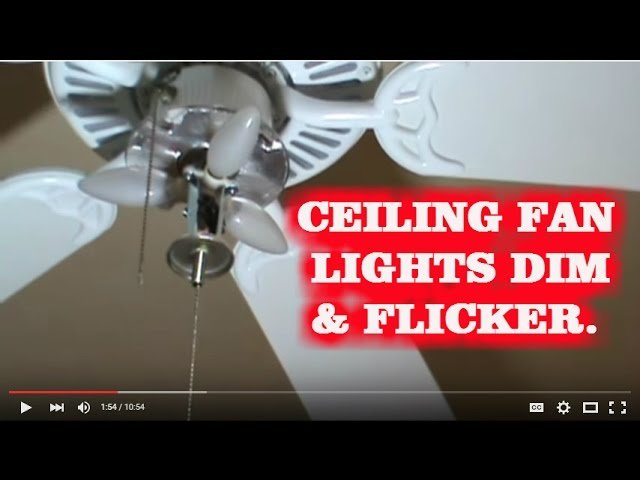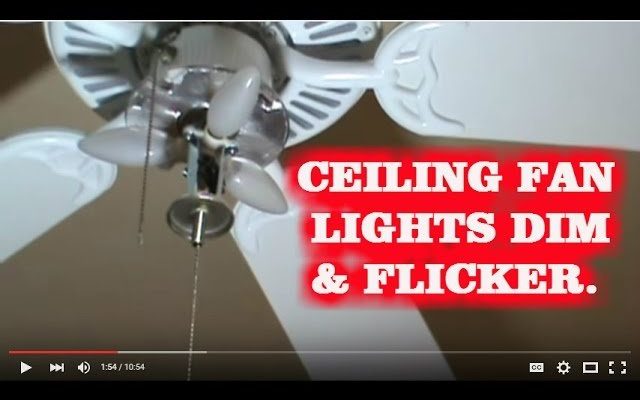
The truth is, a ceiling fan with an attached light is like a little orchestra. The remote acts as the conductor, telling the fan and lights what to do. When the music’s off—er, the lights are flickering—something in that communication chain is out of tune. Sometimes it’s the batteries, sometimes it’s interference, or maybe the remote just needs a reset. The good news? You don’t have to call an electrician every time things go wonky. Let’s break down how to fix flickering lights with your Hunter ceiling fan remote, step by step.
Understanding Why Your Ceiling Fan Lights Flicker
You might be wondering, “Isn’t flickering just an old bulb problem?” Not always. With a Hunter ceiling fan that’s remote-controlled, things can get a bit more complicated. The remote doesn’t just turn the lights on and off; it actually sends a code to a receiver in the fan, which handles both light and fan speed settings. If that communication hiccups, your lights might strobe, dim, or flicker unexpectedly.
Common causes include loose bulb sockets, faulty bulbs, or dirty contacts. But in a lot of cases with modern fans, the issue comes down to something with the remote or receiver. Electrical interference—think Wi-Fi routers, microwaves, or even another remote nearby—can mess up the signals. Also, if you’re using bulbs that don’t play nice with dimmer functions (especially older LEDs or CFLs), you may see odd behavior when you try to dim or brighten.
Here’s the thing: most flickers aren’t dangerous, but persistent flickering can wear out bulbs and be incredibly distracting. Plus, nobody wants to eat dinner under a disco strobe. That’s why it’s worth a deeper look at your Hunter remote and setup before you start swapping every lightbulb in the house.
Checking the Obvious: Bulbs, Batteries, and Connections
Let me explain what usually works first—sometimes the simplest solution is the winner. Before diving into code resets or advanced troubleshooting, grab a chair (safely, please!), and check the bulbs themselves. Make sure they’re the right wattage and type for your Hunter fan. Screw them in tightly. Sometimes a loose bulb causes more chaos than you’d expect.
Now for the batteries in your Hunter remote. Fresh, high-quality batteries mean stronger signal and fewer weird issues. If your lights flicker or the remote seems unresponsive, pop the battery cover off and swap in new ones. Your remote might technically “work” with weak batteries, but weak signals can create all kinds of miscommunication with your fan.
Don’t skip the fan’s connections. With the power OFF at the breaker, check the canopy (the part at the ceiling). Wiring should be tight; any exposed or dangling wires can interfere with the remote’s signals or the power supply. A wobbly receiver might also lose its connection—imagine trying to talk on a phone that keeps dropping its call.
Hunter Ceiling Fan Remote: How It Controls the Light
Think of the Hunter remote as a little radio station and the receiver in your fan as a tiny radio. The remote sends out a specific code (or frequency), and the receiver interprets it, telling the lights to turn on, off, or dim. If these get out of sync, or if another device is sending a similar frequency, your lights might misbehave.
Not every remote is created equal. Some Hunter remotes are universal, while others are specially paired to your fan model. Universal remotes can have more interference issues, especially in houses with several fans. Brand-paired remotes (original Hunter remotes made for your unit) usually work best. Using third-party remotes or codes that don’t quite match can confuse the receiver, leading to—you guessed it—flickering lights.
You might notice flicker when you try to dim the lights. This is because not all bulbs handle electronic dimming gracefully. Check your bulb specs: if they’re labeled as “dimmable LED” or “dimmable CFL,” they should work, but even then, some cheaper bulbs can struggle. Swapping in high-quality, dimmable bulbs often fixes odd strobing or flickering.
Resetting and Re-Syncing Your Hunter Fan Remote
So, you’ve checked bulbs and batteries, and the wiring looks good. Still flickering? Time to try a reset or re-sync. This process essentially “reintroduces” the remote and receiver, clearing up any mixed codes or glitches.
Here’s a classic step-by-step for resetting Hunter ceiling fan remotes:
- Turn the fan off at the wall switch or breaker, and wait at least 30 seconds.
- Turn the power back on.
- Within 30 seconds, press and hold the “Sync” or “Pair” button on the remote (sometimes you hold the “Fan” and “Light” buttons together—check your remote’s label or manual).
- Wait for the fan to respond—usually, the light blinks or the fan speeds up for a second.
- Test the remote by toggling the light on and off, and running the dimmer.
If the sync worked, your receiver and remote now “speak the same language” again. This clears out odd codes that might have been sent by accident, fixing weird flickers. If it doesn’t, try new batteries and reset once more. Still no luck? The receiver itself could be failing or getting too much interference—more on that below.
Troubleshooting Persistent Flickering: Interference and Receiver Issues
Honestly, interference is the sneaky cause nobody expects. Wi-Fi, Bluetooth speakers, microwaves, wireless doorbells—even garage door remotes—can throw off your Hunter remote signals. If your fan flickers mainly when other electronics are active, this could be your culprit.
What can you do? First, move potential sources of interference away from the fan, if possible. Next, consider re-coding your remote. Some Hunter remotes allow you to set a new frequency (there are tiny dip switches inside the battery compartment, kind of like setting a garage door code). Set both the remote and receiver to the same new code, and see if that stops the flicker.
Sometimes, though, the internal receiver in the fan starts to fail. The receiver is a small, black box inside the fan’s canopy, and over time, it can develop glitches. If new remotes, batteries, and bulbs don’t work, replacing the receiver is your next step. Just make sure you buy a Hunter-compatible part—mixing brands or models can make things even weirder.
Insight: If your fan worked perfectly for years and suddenly started flickering, a new device in your home (router, phone, smart TV) could be interfering. Check what changed recently.
Choosing the Right Bulbs for Hunter Fan Remotes with Dimmer
Here’s where bulb selection really matters. If your Hunter remote includes a dimmer function, *not* all bulbs will play nice. Non-dimmable bulbs can flicker, hum, or even burn out early if you try to dim them with the remote.
Stick to these guidelines for best results:
- Only use “dimmable” bulbs—look for this word on the package.
- LEDs are energy-efficient, but buy ones labeled “for ceiling fans” or specifically “dimmable with electronic dimmers.”
- Avoid mixing bulb types (like CFL and LED in one fixture)—consistency helps the receiver work smoothly.
- Check the maximum wattage allowed for your fan’s light fixture and don’t exceed it.
If in doubt, test one bulb at a time. Replace all bulbs with tried-and-true dimmable LEDs and see if the flicker vanishes. Sometimes it’s a trial-and-error process—what works for one fan setup may not be perfect for another.
Comparing Hunter Brand Remote vs Universal Remotes for Ceiling Fans
It’s tempting to grab a universal remote if you’ve lost the original, but they aren’t always perfect with Hunter ceiling fans. Here’s why:
- Hunter brand remotes are made specifically for their fans, using codes and frequencies tuned for that lineup. They’re usually “plug-and-play,” syncing right away and giving you all the features your fan supports (lights, speed control, dimming).
- Universal remotes are designed to work with many brands, but sometimes lose special features or can introduce communication lags. You might find that the lights or dimming don’t work as expected, or strange flickers start after setup.
If your lights started flickering after switching to a universal remote, that’s probably your problem right there. Swapping back to a genuine Hunter remote (or original receiver) often solves the trouble. If you must use a universal remote, choose one that lists Hunter compatibility and make sure you set the correct code.
When to Call in a Pro (And When You Can DIY)
Most of the time, you can fix flickering lights with some patience and a good set of batteries. But if you’ve reset, re-coded, swapped bulbs, and checked all connections—and nothing works—it might be time to consult a professional.
Here’s the line: if you’re comfortable with ladders, breakers, and matching wire colors, replacing a receiver or remote is a solid DIY project. If the issue might be in your home’s electrical wiring (like flickering in every room), or if you see (or hear) buzzing, burnt smells, or hot spots—definitely call an electrician. Safety first.
For most, fixing flickering lights with your Hunter ceiling fan remote is like solving a little household puzzle. With careful troubleshooting, most folks are back to smooth, steady lights in no time.
Wrapping Up: Enjoying Steady Lights Again
Nobody really wants to think about their ceiling fan until something goes haywire. Flickering lights can be a huge headache, but once you know how the Hunter remote, receiver, and bulbs work together, it’s much less mysterious. Start with the basics—bulbs, batteries, wiring—then step up to resets or re-syncing if things still look spooky.
Here’s the thing: When you take the time to understand how your remote controls your lights, you’re less likely to feel lost the next time something flickers. And that’s worth the effort—all so you can read, relax, or just enjoy your living room without feeling like you’re at a rave.
